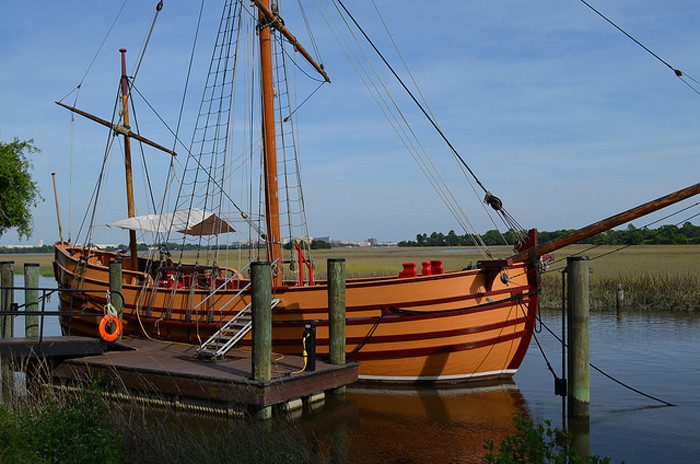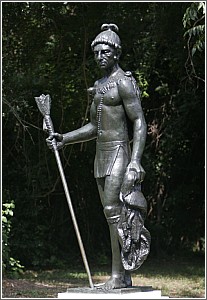KIAWAH
When Capt. Robert Sanford and Dr. Henry Woodward explored the Carolina coast in 1666 for the Lords Proprietors in anticipation of developing a new colony, this area was home to about 2,000 Native Americans representing 19 tribes. The English expedition put ashore near what is now Rockville, where they were amiably greeted by the Cassique, or chieftain, of a loosely federated group of tribes known collectively as the Keyawah (spellings vary).
The Cassique sought a mutually beneficial alliance with the new settlers, appreciating that the better-armed Englishmen could help defend them against the Spanish in St. Augustine and unfriendly tribes such as the Westos. Capt. Sanford reported back to his patrons that “Amongst these Indians was one who used to come with the Southern Indians to trade with us…and is known by the name of Cassique, hee belongeth to the Country of Kiwaha and was very earnest with mee…promising a large welcome and plentiful entertainment and trade.”
The Kiawah had been in the Charleston area for centuries and knew the landscape well. Their lands lay between the Sewee tribe grounds to the east of Charleston Harbor and the Edistos' lands to the south. In addition to hunting and fishing, they also farmed, though not in the intensive fashion of Europeans, neither sowing, weeding or tending crops on a routine basis. They supplemented any low crop yields by fishing and gathering. In the fall, they migrated to inland hunting grounds to track deer. Recent archaelogical finds show that heir trade networks went as far inland as Mississippi.
Women did most of the farming and gathering and made pottery for cooking. Yet within the Lowcountry's Native American society, women enjoyed more status than in many other societies; some even rose to chieftain status. Many South Carolina coastal tribes traced descent through matrilineal lines. Rising chiefs were chosen from the children of the chieftain’s sister, and men lived with their wives’ families in thatched communal houses. Early colonists recounted that Kiawah women wore moss robes, often with necklaces made of colorful beads. The men wore deerskins.
Even as the Cassique sought the friendship and protection of the well-armed English from his enemies, the Kiawah in turn played a crucial role in helping the 148 passengers who landed aboard The Carolina in 1670 gain a foothold in the New World. They shared their knowledge of farming and crops, such as it was, with the settlers and invited them to make their home with the tribe at Albemarle Point, about 10 miles up the Ashley River from today's Charleston penisula.
Shortly after landing in April of that year, more than 200 Spanish and another 300 Stono tribesmen allied themselves and traveled up the Stono Inlet with the intention of destroying the young English settlement. Early colonist Stephen Bull recalled in a letter home: “All the Indians came with their full strength to our Ayde” to protect the settlement from attack.
Without the Kiawah's help, the English explorers may not have been successful in Carolina. Nicholas Carteret described the Cassique as an “Ingenious Indian and a great Linguist” whose tribe helped them clear and plant land. Another settler wrote, “Wee found very great Assistance from the Indians who shewed them selves very kinde and sould us Provisions att very reasonable rates and takeinge notice of our necessitys did almost daylie bring one thinge or another otherwise wee must undoubtedly have binn putt to extreame hardshipps.”
Though the English and the Kiawah maintained a mutually supportive relationship, the Europeans' arrival was the beginning of the Natives' demise. Smallpox brought by settlers took a heavy toll on the Native populations. In addition, competing tribes tried to capture one another to trade to the Spanish as slaves. The Kiawah were a small tribe in 1670; by the 1680s they comprised about 160 men, women, and children, 40 of whom were warriors.
Unfortunately their numbers continued to diminish after the English settlers' arrival as disease continued to kill Natives who had no immunity to European diseases. As coastal tribes decreased in size, many ceded their lands to the English settlers. In March 1675, the Kiawah traded lands “lying on the river of Kyewaw the River of Stono and the Freshes of the River of Edistoh” in exchange for cloth and other manufactured goods.
Colonists relocated the settlement from Albemarle Point to the peninsula (its current location) in 1680 for a variety of reasons, including defense and relief from the mosquitos. For a whie, their original settlement along the Ashley River appeared on maps as “Kiawah sometimes called Charles Towne,” but by 1684 the Kiawah exchanged their remaining lands on the Ashley River and resettled on what we now know as Kiawah Island today.
Kiawah life changed as their land holdings shrunk. In a 1687 expedition to Kiawah Island, Captain William Dunlop encountered the Cassique, settled on the banks of Kiawah Creek. He observed that the tribe was planting corn, peas, and beans extensively at their settlement site, a marked change from the less rigid planting practices the Kiawah had used when they had more land on which to hunt.
The Kiawah still had a few warriors among them in 1695, when an act was passed requiring men of local Native tribes, “including the Kiaway,” to pay annual tribute to the English in the form of one wolf, tiger, or bear pelt, or the skin of two wild cats." By 1699, however, there were so few Indians living on Kiawah Island that the Lords Proprietors granted the island to Capt. George Raynor (generally believed to have been a privateer who decided to settle down).
Kiawah settlements appear on local maps as late as 1730, a time when much of the island was an active plantation. In 1743, 15 homeless Kiawah tribe members approached the Lieutenant Governor and were granted a site south of the Combahee River; this is one of the last mentions of the Kiawah tribe in English records. Governor William Bull noted that in 1670 the Lowcountry had been teeming with Native Americans, but by 1770, little remained of them but place names. Still, a remnant of the tribe survived, migrating to Tennessee and known today as the Guaymari Kiawah, meaning "The Sacred People of the Earth."
Layers of Native American history are waiting to be explored throughout the Lowcountry. In 1956 by sheer chance, a fisherman discovered a 900-year-old, 35' long dugout canoe partially buried in a sand dune about a mile inland from the beachfront on Kiawah Island. Physical reminders of the Kiawah have also surfaced when settlement sites are unwittingly discovered during development projects. A Kiawah house and burial site was unearthed in 1969 at Charles Towne Landing during the construction of a pavilion for the South Carolina Tricentennial Celebration of the English settlement. Archeology crews scrambled to excavate and document artifacts before the pavilion was built. It was roughly 200 feet square with log structural supports (workers found post holes outlining the footprint). Archaeologist Stanley South described the house as “one of the greatest [finds] in the southeast.”
Locally, the Kiawah’s heritage survives today through place names and accounts of their pivotal role in aiding the early English settlers. Exhibits at The Charleston Museum remind visitors of the Kiawah through its collection of artifacts. Visitors can also learn more about the Kiawah at Charles Towne Landing State Park, as Albemarle Point is known today. For more information on the current Kiawahs living in Tennesee, visit the Guaymari Kiawah website.






